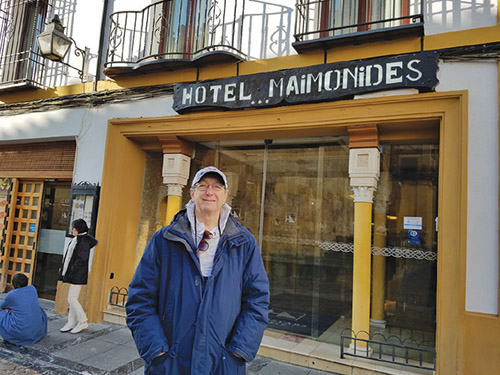



Cordoba, Madrid, Toledo, Malaga and other Spanish towns and cities are places I have taught about in my high school Jewish history classroom for years.
These, of course, are places largely of the past when it comes to Jewish community. Leading up to 1492, some 150,000 Jews lived and flourished in these places.
Post 1492, they were either killed, forced to convert or expelled. The world knows them by the terms conversos or crypto-Jews or even the awful description marrano or swine.
I was thinking about the math involved. That if those 150,000 had been allowed to live their lives in prosperity and spirituality, perhaps Spain would have some 2 or 3 million Jews living there today. I know that’s amateur arithmetic. But I could not help thinking about the possibility of visiting these sacred places where Jews courageously lived double lives, where some had two cholent pots, one used for pork to give the impression they had given up their Judaism, the other for kosher meat in a desperate attempt to maintain their faith.
The opportunity came a couple of weeks past when I helped chaperone a class of 11th-grade Spanish students at the Beth Tfiloh Dahan Community High School in Pikesville, Maryland, where I teach Jewish history.
Spain and its countryside are picturesque. We saw windmills, castles and the postcard-like Mediterranean’s seashore. Narrow streets, fortress-like city walls remind one easily of Jerusalem.
I found that I was constantly fighting the noise in my ears, like some sort of spiritual tinnitus, that this beautiful countryside, cities and towns are occupied by best estimates of perhaps 25,000 Jews in a population of 80 million, and that in 1492, the 150,000 victims of the Inquisition lived among 8 million. The noise for me was the voices of Jewish life and lives lost to history.
Therefore, in retrospect, I will accentuate the positive. Three experiences.
There is for an observant Jew something so incredible and difficult to describe when first seeing the statue of the Rambam in Cordoba. There are statues that we have all seen in our lives, be it presidential or a war hero or dating back to Greek or Roman times. However, to see this statue of someone who is of influence to the Jewish people today, and has been for centuries, with his Mishneh Torah, Guide to the Perplexed and so much more, brings with it a sense of history and reverence that is overwhelming. I felt as if I had made it to a higher spiritual place just by seeing the statue and walking the streets of Cordoba. Even though the Rambam is buried in Tiberias. History tells us that Cordoba would be labeled a “scandal against Christianity” when it was conquered by the Christians. No, the “scandal” was that Maimonides was forced to flee by the Almohade persecutions of the times.
On our Wednesday, we visited the coastal town of Malaga. Again, gorgeous. For me and for many of the students one of the high points of our journey came with a visit to the nearby La Communidad Israelita De Malaga.
There, we were welcomed by the shul’s youth group. It was amazing to see American teens and Spanish teens, speaking their best English and Spanish with one another with Hebrew mixed in. They automatically clicked, turning the evening into a festive get-together that was difficult to end. Of course the traditional food served that evening to the teens: hamburgers and fries. Welcome Americans!
Malaga, which is home to several hundred Jews, was the land of the Sephardic poet Shlomo Ibn Gabirol. The landscape of the town and its location on the Mediterranean included an old Sephardic quarter and the site of a medieval synagogue.
On Shabbos night, we were hosted by the Communidad Judea de Madrid, an Orthodox shul, that helped us welcome the Shabbos Queen with meaning and spirituality. The shul’s minhag was for various congregants to sing parts of Kabbalat Shabbat with traditional Sephardic niggunim that seemed so wonderfully home grown, they brought tears to my eyes.
Our class had dinner together, and as I told them, even though we study so much about the expulsion of the Jews, we were taking part that evening in a vital, living congregation in the nation’s capital and largest city. The shul’s rabbi made sure to give us part of his challah. We could hear singing coming from the congregational meal. It was a wonderful experience.
Most of our meals, by the way, were catered by the nearby kosher Pinati Restaurant. Its owner opened the restaurant just for our class for Shabbat lunch and Seudat Shlishit.
During Havdallah services, we talked about taking the entire experience of Spain home with us and sharing it with our family and friends. So much of the foundation of Jewish continuity is connected to Spain. And we were blessed to see it.
By the time the week was over, we had visited Madrid, Toledo, Ubeda, Malaga, Ronda, Seville and Cordoba. We had seen Spain’s “secret synagogue,” the Sephardic Museum, the Old Quarter of Toledo and just so much more.
I sit here now back in America and I am still in awe of how the Sephardic community influenced world Jewry even when Christianity tried to extinguish its flame. I wonder how these Spanish communities would have grown and thrived if they had been given the opportunity.
Still I recommend this journey. Many of us outside of the Sephardic community are well versed in Eastern European Jewish history. As our Sephardic brothers and sisters know, there is an incredible story that needs to be told and learned by us all.
Adios Spain…for now.
By Phil Jacobs
�









